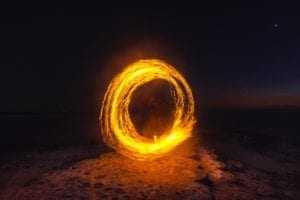Sue Stevenson
Melbourne, Australia

Person Performing Fire Dance at Night by Maris Rhamdani, 2018, on Pexels.
The compression socks assist with my low blood volume but they look terrible with my summer dress. Secondhand, $12 on eBay, a 1940s cut with flowers and cap sleeves. The compression socks remind me of ancient old ladies and while I am a year shy of half a century, I am still not at the point of wearing them visibly in public. They are the last bastion between here and entirely letting go, and just because my body has given up producing enough blood to satisfy our requirements, just because my veins are too pooped to shunt it back up my legs so that the blood pools in my ankles, it does not mean my ego has given up being vain.
Anyway, it is far too hot. Mid-January, midsummer, and not one person is on the street except for a lone telecoms worker. Everyone else is inside, shut up not against the heat but the smoke. It is not as bad as some other days, though I could smell it when I woke this morning and it backdrops the trees in gray.
The smoke is from the fires burning in Mallacoota. That place and all the others that have burned in Australia this summer have become well-known to people all over the world. On the front page of a newspaper being read in winter cold, a photo of a blood-red sky reduces the bright orange of a firefighter’s uniform down to a monochrome gray. I cannot think of it for long, cannot bear it—the estimated half a billion bodies, furred and feathered and lizardskinned, charred.
I cannot think of it for long, and so I go for this little walk to the top of the street and back, to feel free, a walk my myalgic encephalomyelitis disallows me to do for great swaths of months and years. But over the last month I have improved enough to walk it several times, sinews stretching, lymph and blood flowing around my body, telling me I am alive.
My street had koalas in it once but not for a long time now. It was actually meant to be called Koala Street, but when they lodged the name at the council office it was spelled wrongly, with the o and the a transposed, so that now I live in a dyslexic koala street with no koalas in it.
I keep thinking of them, those half a billion bodies whose blood was pulsing in November and who are now silenced. The government was woefully unprepared. Its priorities are evident in its funding: billions on submarines to fight empire games but reduced funding for environmental services, which could have been paid for several times over by the taxes our monstrously rich coal mines do not pay.
This inflammatory system is not tenable. The anger roars through our veins. We must go to water.
I think of the koala, the one someone said was screaming. Then I think, to solace and calm myself, that it is at peace now. I think of the animals all over the country whose burns and hypovolemia and shock are being tended by beautiful people. I think of those who lost their lives, their houses, their livelihoods, being tended with care and the millions of dollars donated to the Red Cross to help them get back on their feet.
This country, if seen as one body, it too has low blood volume. We all live here, we all breathe in these fumes now, but some of us are greedy and cannot will the blood to flow freely, nourishing all the organs and tissues. The blood in this body pools in its ankles, too, rich nourishment hoarded by those who have far too much.
My spiritual heritage is buried across the ocean, underneath British soils which were long, long ago plundered by Saxons and Normans. But this we know: the Celtics and Aboriginal Australians both held to the power of ley lines, running like veins on the earth. Many of them have songlines linked to them, audio songs mapping the land, connecting vast distances.
This idea that the earth may have vessels of energy seems childish. Well, bring on the childishness, I say. Pour it in like blood. The more we can humanize the earth—or is it perhaps earthizing the humans?—the less inclined we will be to spit in her face and expect her to endure our endless extraction without her ever speaking back.
Well, now she has spoken back. And now we all must listen. We need as many stories we can get.
SUE STEVENSON lives on the edge of the hem of Melbourne’s outskirts in a fine tree-to-human ratio. She likes hugging both.
Submitted for the 2019–2020 Blood Writing Contest

Leave a Reply